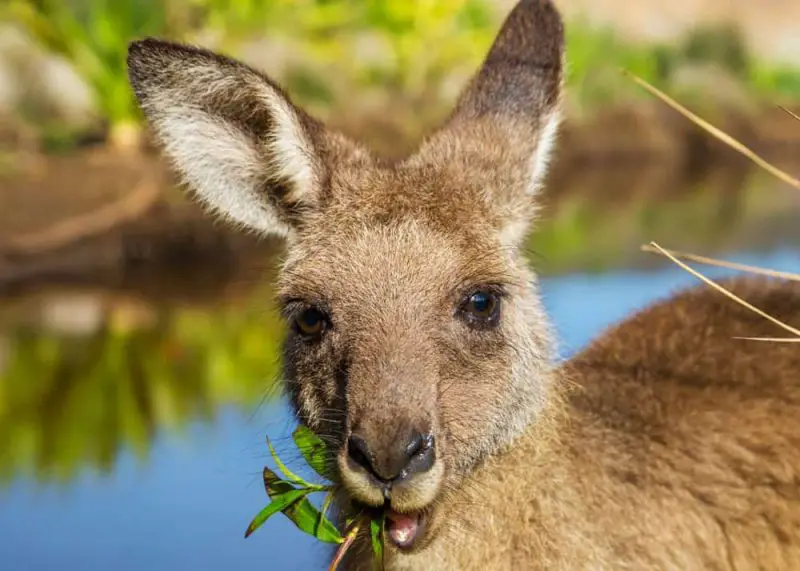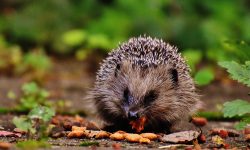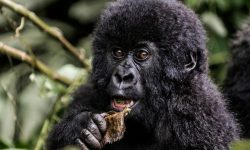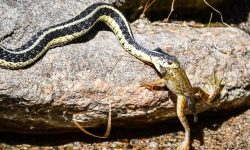Kangaroos are some of the most recognizable animals in the world, thriving across Australia’s grasslands, woodlands, coasts, and deserts. Their unique feeding habits allow them to survive in environments where food and water can be limited. By relying on a wide variety of plants, they stay healthy and active year-round.
In the wild, kangaroos spend much of their day grazing or browsing, choosing foods that offer both nutrients and hydration. Their strong jaws and flexible feeding behavior help them consume tough grasses, fibrous shrubs, and even drought-resistant vegetation that many animals avoid. This adaptability allows them to handle seasonal changes with ease.
Understanding what kangaroos eat not only helps us appreciate their biology but also highlights their role in maintaining plant balance across Australian ecosystems. Their diet supports soil health, spreads seeds, and influences vegetation patterns. Below is a clear explanation of how their digestive system works before exploring the 20 foods they love most in the wild.
Understanding the Kangaroo Diet

Kangaroos are strict herbivores with a highly efficient digestive system designed to process fibrous plants. Their chambered stomachs use fermentation to break down vegetation slowly, allowing them to extract nutrients from even dry or coarse grasses. This system helps conserve energy and supports survival in unpredictable environments.
In natural habitats, kangaroos eat a flexible mix of grasses, shrubs, herbs, flowers, and soft foliage. Their diet changes depending on rainfall, temperature, and plant availability. Because they can both graze close to the ground and browse from taller shrubs, kangaroos easily adjust to seasonal vegetation shifts.
Hydration also plays a major role in their feeding patterns. Kangaroos obtain most of their water directly from plants, which reduces the need to drink from rivers or ponds. This adaptation enables them to thrive in semi-arid plains, open woodlands, and inland regions where water sources are often scarce or temporary.
20 Foods Kangaroos Love in the Wild
1. Fresh Grasses
Fresh grasses form the core of a kangaroo’s diet, especially for species like the Eastern Grey Kangaroo. These grasses offer fiber, moisture, and essential nutrients that keep digestion smooth and energy levels stable.
Kangaroos graze most actively at dawn and dusk when grasses hold higher moisture, helping them stay hydrated in hot climates. Young shoots are especially preferred because they are tender and rich in natural sugars.
Large grasslands across Australia provide endless foraging areas, allowing kangaroos to move freely while maintaining a consistent food supply.
2. Spinifex Grass
Spinifex grass grows in dry, sandy environments where few other plants thrive. Its tough blades may seem harsh, but kangaroos consume the softer inner segments that offer hydration and digestible fibers.
This grass is crucial during drought seasons, when softer vegetation becomes limited. Despite its coarse exterior, spinifex helps sustain kangaroo populations in Australia’s harsh desert regions.
Its widespread availability ensures that kangaroos living far from wetlands or woodlands still have dependable nourishment.
3. Wallaby Grass
Wallaby grass is a soft, fine-bladed grass that kangaroos prefer for its high moisture content and gentle texture. It grows well after rainfall, producing lush patches ideal for grazing.
Because it is easy to chew, kangaroos can consume large amounts quickly, supporting their high energy needs. This grass is often abundant in open woodlands and savannas, making it widely accessible.
During wetter seasons, wallaby grass becomes one of the most nutritious and refreshing foods available to kangaroos.
4. Kangaroo Grass
Kangaroo grass, named after these iconic animals, is a native plant found across much of Australia. Its tender leaves supply protein and minerals important for daily muscle activity.
Kangaroos graze on this grass when it is young and green, taking advantage of its moisture-rich blades. Older, dried growth becomes less desirable but may still be eaten during scarcity.
Its resilience in warm climates makes it a consistent component of the kangaroo diet all year long.
5. Shrub Leaves
Many kangaroo species browse on shrub leaves when grasses are limited. These leaves provide vitamins, antioxidants, and hydration from their natural sap.
Shrubs such as saltbush, wattle, and hopbush grow widely in semi-arid regions, offering dependable food during dry spells. Their broad leaves are also easier to reach for larger kangaroo species.
By mixing shrub foliage into their diet, kangaroos balance rough grasses with softer, nutrient-rich plant tissues.
6. Saltbush
Saltbush is one of the most important drought-resistant plants in Australia. Its leaves contain minerals and moisture that help kangaroos manage heat stress and dehydration.
These leaves taste slightly salty due to natural mineral deposits, but kangaroos digest them easily. Saltbush thrives where rainfall is minimal, making it essential for survival in arid regions.
Because it stays green year-round, kangaroos rely on saltbush heavily during long dry seasons.
7. Mulga Leaves
Mulga trees produce thin leaves perfectly adapted to desert climates. Kangaroos browse these leaves frequently, especially when ground vegetation is scarce.
Mulga leaves provide moisture and carbohydrates that support energy through long periods of foraging. Their flexible branches allow kangaroos to pull leaves down easily.
In mulga woodlands, this tree becomes a primary food source for several kangaroo species.
8. Wattle Leaves
Wattle trees grow rapidly after rain, producing fresh leaves that kangaroos consume eagerly. These leaves contain natural sugars that offer quick energy.
Because wattles are widespread across Australia, kangaroos encounter them often during foraging routines. Their soft foliage is ideal for kangaroos of all ages, including joeys learning to browse.
Wattle leaves also store moisture, reducing the need for kangaroos to travel long distances for water.
9. Flowers
Kangaroos frequently feed on blossoms from native shrubs and trees. Flowers contain nectar, minerals, and soft plant tissues that are easy to chew and digest.
During blooming seasons, kangaroos may travel specifically to areas where flowers are abundant. These colorful treats add sweetness and nutritional variety to their diet.
Flower consumption also helps kangaroos conserve water because blossoms naturally retain moisture.
10. Seed Pods
Seed pods from acacias, wattles, and other shrubs are rich in fats and proteins. Kangaroos use their strong jaws to crack open pods for the nutritious seeds within.
These pods become increasingly important during late dry seasons when fresh greenery is scarce. High-energy seeds help kangaroos maintain body weight and stamina.
Because pods remain on trees long after leaves fall, they offer a reliable food backup.
11. Fruits
Wild fruits such as bush tomatoes, quandongs, and native plums provide hydration and vitamins. Kangaroos consume ripe fruits when available, typically during the wet season.
These fruits help boost immunity and energy, offering natural sugars and antioxidants. Kangaroos may also eat fallen fruit when trees are too tall to browse directly.
Fruit-rich patches become popular feeding grounds, attracting several kangaroos at once.
12. Roots
When vegetation becomes extremely limited, kangaroos may dig for roots and tubers using their front paws. These underground foods store nutrients and moisture.
Roots provide slow-release energy and help kangaroos survive drought or extreme heat. Although tougher to access, they offer dependable nourishment.
This survival behavior reflects the kangaroo’s remarkable adaptability in harsh landscapes.
13. Bark Strips
In harsh seasons, some kangaroos nibble thin strips of bark from soft-barked trees. Bark offers fiber and trace minerals that help maintain digestive function.
While not their preferred food, bark helps prevent starvation during extended droughts. Kangaroos usually target young trees with easily removable layers.
This emergency food strategy ensures survival during rare periods of extreme scarcity.
14. New Shoots
After rain, new plant shoots appear in abundance. These tender, moisture-packed growths are incredibly attractive to kangaroos.
New shoots are rich in natural sugars that provide quick bursts of energy. They also help refresh hydration levels after long dry periods.
Kangaroos often follow rain patterns to locate areas where fresh shoots are emerging.
15. Ferns
In wetter habitats, kangaroos may browse on soft fern fronds. These plants store plenty of moisture, helping kangaroos stay hydrated.
Ferns offer a mild, easily digested plant source during rainy seasons. They add valuable dietary variety, balancing harder, dry-season foods.
Forest edges with dense fern growth become prime grazing locations after storms.
16. Bulrushes
Near wetlands, bulrushes grow thickly in soft soil. Kangaroos consume their stems and leaves when water sources draw them closer.
Bulrushes contain high moisture and moderate fiber, supporting hydration and digestion. These plants are especially important for kangaroos living in riverine environments.
Their constant growth ensures year-round availability.
17. Wild Herbs
Kangaroos occasionally browse wild herbs such as mint bush, native thyme, or wild sage. These herbs contain aromatic compounds beneficial for digestion.
Herbs provide nutrients not found in grasses alone, supporting general health. Kangaroos select herbs based on smell, often choosing the freshest growth.
These small plants help diversify the kangaroo diet during mild seasons.
18. Coastal Vegetation
Near beaches, kangaroos may graze on salt-tolerant plants like pigface or coastal grasses. These plants contain water-rich tissues important in hot coastal climates.
Coastal vegetation allows kangaroos to forage near sea breezes where temperatures are cooler. Their natural salinity also helps balance mineral levels.
These foods highlight the kangaroo’s ability to thrive in various ecosystems.
19. Leaf Litter
When food options run low, kangaroos may eat partially dried leaves found on the ground. Leaf litter offers minimal nutrients but helps fill the stomach during scarcity.
This behavior occurs mostly during severe droughts when fresh foliage is absent. Even low-quality plant matter can keep digestion functioning.
Leaf litter prevents dangerous fasting periods in extreme climates.
20. Water-Rich Succulents
Some kangaroos consume succulents like pigweed or native desert plants with thick, fleshy leaves. These plants store water internally, helping kangaroos stay hydrated.
Succulents are particularly valuable in arid inland regions where standing water is rare. They provide moisture, minerals, and electrolytes.
This natural hydration source enables kangaroos to survive long periods without drinking.
FAQs About Kangaroo Diet
Do kangaroos only eat plants?
Yes. Kangaroos are herbivores and consume grasses, leaves, shrubs, and plant shoots.
How often do kangaroos eat?
They graze for many hours each day, especially during early morning and late afternoon.
Do kangaroos drink water daily?
Not always. Many kangaroos get most of their hydration from plants.
Can kangaroos eat fruit?
Yes, but only seasonally when wild fruits naturally ripen.
What do baby joeys eat?
Joeys drink milk from their mothers until old enough to eat vegetation.
Do kangaroos eat seeds?
They sometimes eat seeds from pods, especially in dry seasons.
What food helps kangaroos survive drought?
Saltbush, mulga, and spinifex grass help them survive harsh conditions.
Do kangaroos forage at night?
Some species forage at night to avoid high temperatures.
Are kangaroos selective eaters?
Yes. They choose plants based on freshness, moisture, and season.
What plant gives kangaroos the most hydration?
Fresh grasses and succulents are the best hydration sources.
Final Thoughts
Kangaroos survive Australia’s diverse climates by relying on a flexible and plant-rich diet. Their ability to browse, graze, and adapt to seasonal vegetation ensures they stay healthy even in harsh environments. By understanding what kangaroos eat in the wild, we gain a deeper appreciation for how uniquely adapted they are to their landscapes.






